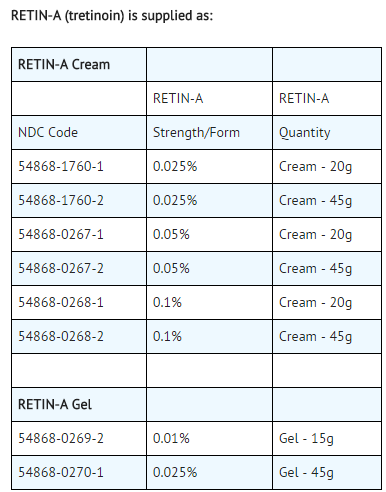Retinol: Difference between revisions
m (Robot: Automated text replacement (-{{SIB}} +, -{{EH}} +, -{{EJ}} +, -{{Editor Help}} +, -{{Editor Join}} +)) |
m (Protected "Retinol": Bot: Protecting all pages from category Drug ([Edit=Allow only administrators] (indefinite) [Move=Allow only administrators] (indefinite))) |
||
| (18 intermediate revisions by 2 users not shown) | |||
| Line 1: | Line 1: | ||
{{ | {{DrugProjectFormSinglePage | ||
| | |authorTag={{Ammu}} | ||
| | |genericName=retinol | ||
| | |aOrAn=a | ||
|drugClass=[[vitamin]] analog | |||
| | |indicationType=treatment | ||
| | |indication=[[acne vulgaris]] | ||
| | |adverseReactions=[[hypopigmentation]], [[hyperpigmentation]], skin [[erythema]] | ||
| | |blackBoxWarningTitle=<span style="color:#FF0000;">ConditionName: </span> | ||
| | |blackBoxWarningBody=<i><span style="color:#FF0000;">ConditionName: </span></i> | ||
| | |||
* Content | |||
<!--Adult Indications and Dosage--> | |||
= | <!--FDA-Labeled Indications and Dosage (Adult)--> | ||
|fdaLIADAdult=* RETIN-A is indicated for topical application in the treatment of [[acne vulgaris]]. The safety and efficacy of the long-term use of this product in the treatment of other disorders have not been established. | |||
* RETIN-A Gel, Cream or Liquid should be applied once a day, before retiring, to the skin where acne lesions appear, using enough to cover the entire affected area lightly. Liquid: The liquid may be applied using a fingertip, gauze pad, or cotton swab. If gauze or cotton is employed, care should be taken not to oversaturate it to the extent that the liquid would run into areas where treatment is not intended. Gel: Excessive application results in “pilling” of the gel, which minimizes the likelihood of over application by the patient. | |||
* Application may cause a transitory feeling of warmth or slight stinging. In cases where it has been necessary to temporarily discontinue therapy or to reduce the frequency of application, therapy may be resumed or frequency of application increased when the patients become able to tolerate the treatment. | |||
* Alterations of vehicle, drug concentration, or dose frequency should be closely monitored by careful observation of the clinical therapeutic response and skin tolerance. | |||
* During the early weeks of therapy, an apparent exacerbation of inflammatory lesions may occur. This is due to the action of the medication on deep, previously unseen lesions and should not be considered a reason to discontinue therapy. | |||
* Therapeutic results should be noticed after two to three weeks but more than six weeks of therapy may be required before definite beneficial effects are seen. | |||
* Once the acne lesions have responded satisfactorily, it may be possible to maintain the improvement with less frequent applications, or other dosage forms. | |||
* Patients treated with RETIN-A ([[tretinoin]]) acne treatment may use cosmetics, but the area to be treated should be cleansed thoroughly before the medication is applied. | |||
|offLabelAdultGuideSupport=There is limited information regarding <i>Off-Label Guideline-Supported Use</i> of {{PAGENAME}} in adult patients. | |||
<!--Non–Guideline-Supported Use (Adult)--> | |||
|offLabelAdultNoGuideSupport=There is limited information regarding <i>Off-Label Non–Guideline-Supported Use</i> of {{PAGENAME}} in adult patients. | |||
<!--Pediatric Indications and Dosage--> | |||
<!--FDA-Labeled Indications and Dosage (Pediatric)--> | |||
|fdaLIADPed=There is limited information regarding <i>FDA-Labeled Use</i> of {{PAGENAME}} in pediatric patients. | |||
<!--Off-Label Use and Dosage (Pediatric)--> | |||
= | <!--Guideline-Supported Use (Pediatric)--> | ||
|offLabelPedGuideSupport=There is limited information regarding <i>Off-Label Guideline-Supported Use</i> of {{PAGENAME}} in pediatric patients. | |||
<!--Non–Guideline-Supported Use (Pediatric)--> | |||
|offLabelPedNoGuideSupport=There is limited information regarding <i>Off-Label Non–Guideline-Supported Use</i> of {{PAGENAME}} in pediatric patients. | |||
<!--Contraindications--> | |||
|contraindications=* Use of the product should be discontinued if hypersensitivity to any of the ingredients is noted. | |||
|clinicalTrials=There is limited information regarding <i>Clinical Trial Experience</i> of {{PAGENAME}} in the drug label. | |||
|postmarketing=* The skin of certain sensitive individuals may become excessively red, edematous, blistered, or crusted. If these effects occur, the medication should either be discontinued until the integrity of the [[skin]] is restored, or the medication should be adjusted to a level the patient can tolerate. True contact [[allergy]] to topical tretinoin is rarely encountered. | |||
* Temporary hyper or [[hypopigmentation]] has been reported with repeated application of RETIN-A. Some individuals have been reported to have heightened susceptibility to sunlight while under treatment with RETIN-A. To date, all adverse effects of RETIN-A have been reversible upon discontinuance of therapy | |||
|FDAPregCat=C | |||
|useInPregnancyFDA=* Oral tretinoin has been shown to be teratogenic in rats when given in doses 1000 times the topical human dose. Oral tretinoin has been shown to be fetotoxic in rats when given in doses 500 times the topical human dose. | |||
* Topical tretinoin has not been shown to be teratogenic in rats and rabbits when given in doses of 100 and 320 times the topical human dose, respectively (assuming a 50 kg adult applies 250 mg of 0.1% cream topically). However, at these topical doses, delayed ossification of a number of bones occurred in both species. These changes may be considered variants of normal development and are usually corrected after weaning. There are no adequate and well-controlled studies in pregnant women. Tretinoin should be used during pregnancy only if the potential benefit justifies the potential risk to the [[fetus]]. | |||
|useInPregnancyAUS=* '''Australian Drug Evaluation Committee (ADEC) Pregnancy Category''' | |||
=== | There is no Australian Drug Evaluation Committee (ADEC) guidance on usage of {{PAGENAME}} in women who are pregnant. | ||
{{ | |useInLaborDelivery=There is no FDA guidance on use of {{PAGENAME}} during labor and delivery. | ||
|useInNursing=* It is not known whether this drug is excreted in human milk. Because many drugs are excreted in human milk, caution should be exercised when RETIN-A is administered to a nursing woman. | |||
|useInPed=There is no FDA guidance on the use of {{PAGENAME}} with respect to pediatric patients. | |||
|useInGeri=There is no FDA guidance on the use of {{PAGENAME}} with respect to geriatric patients. | |||
|useInGender=There is no FDA guidance on the use of {{PAGENAME}} with respect to specific gender populations. | |||
|useInRace=There is no FDA guidance on the use of {{PAGENAME}} with respect to specific racial populations. | |||
|useInRenalImpair=There is no FDA guidance on the use of {{PAGENAME}} in patients with renal impairment. | |||
|useInHepaticImpair=There is no FDA guidance on the use of {{PAGENAME}} in patients with hepatic impairment. | |||
|useInReproPotential=There is no FDA guidance on the use of {{PAGENAME}} in women of reproductive potentials and males. | |||
|useInImmunocomp=There is no FDA guidance one the use of {{PAGENAME}} in patients who are immunocompromised. | |||
= | <!--Administration and Monitoring--> | ||
|administration=* [[Oral]] | |||
* [[Topical]] | |||
|monitoring=* Alterations of vehicle, drug concentration, or dose frequency should be closely monitored by careful observation of the clinical therapeutic response and skin tolerance. | |||
|IVCompat=There is limited information regarding <i>IV Compatibility</i> of {{PAGENAME}} in the drug label. | |||
=== | <!--Overdosage--> | ||
[[ | |overdose=* If medication is applied excessively, no more rapid or better results will be obtained and marked redness, peeling, or discomfort may occur. Oral ingestion of the drug may lead to the same side effects as those associated with excessive oral intake of [[Vitamin A]] | ||
|drugBox={{chembox2 | |||
| verifiedrevid = 464381333 | |||
| ImageFile =All-trans-Retinol2.svg | |||
| ImageSize = 250px | |||
| ImageName = Retinol | |||
| ImageFile2 = Retinol mol 3D.png | |||
| ImageSize2 = 200px | |||
| ImageName2 = Stick model of retinol | |||
| ImageFile3 = Retinol 3D ball.png | |||
| ImageSize3 = 200px | |||
| ImageName3 = Ball model of retinol | |||
| IUPACName =(2''E'',4''E'',6''E'',8''E'')-3,7-dimethyl-9-(2,6,6-trimethylcyclohex-1-enyl)nona-2,4,6,8-tetraen-1-ol | |||
| OtherNames = | |||
| Section1 = {{Chembox Identifiers | |||
| ChemSpiderID_Ref = {{chemspidercite|correct|chemspider}} | |||
| ChemSpiderID = 393012 | |||
| UNII_Ref = {{fdacite|correct|FDA}} | |||
| UNII = 81G40H8B0T | |||
| InChI1 = 1/C20H30O/c1-16(8-6-9-17(2)13-15-21)11-12-19-18(3)10-7-14-20(19,4)5/h6,8-9,11-13,21H,7,10,14-15H2,1-5H3/b9-6+,12-11+,16-8+,17-13+ | |||
| InChIKey1 = FPIPGXGPPPQFEQ-OVSJKPMPBW | |||
| CASNo = 68-26-8 | |||
| CASNo_Ref = {{cascite|correct|CAS}} | |||
| ChEMBL_Ref = {{ebicite|correct|EBI}} | |||
| ChEMBL = 986 | |||
| PubChem = 1071 | |||
| ChEBI_Ref = {{ebicite|correct|EBI}} | |||
| ChEBI = 17336 | |||
| StdInChI_Ref = {{stdinchicite|correct|chemspider}} | |||
| StdInChI = 1S/C20H30O/c1-16(8-6-9-17(2)13-15-21)11-12-19-18(3)10-7-14-20(19,4)5/h6,8-9,11-13,21H,7,10,14-15H2,1-5H3/b9-6+,12-11+,16-8+,17-13+ | |||
| StdInChIKey_Ref = {{stdinchicite|correct|chemspider}} | |||
| StdInChIKey = FPIPGXGPPPQFEQ-OVSJKPMPSA-N | |||
| SMILES = OC/C=C(/C=C/C=C(/C=C/C1=C(/CCCC1(C)C)C)C)C | |||
| MeSHName = | |||
| ATCCode_prefix = A11 | |||
| ATCCode_suffix = CA01 | |||
| ATC_Supplemental = {{ATC|D10|AD02}}, {{ATC|R01|AX02}}, {{ATC|S01|XA02}} | |||
}} | |||
| Section2 = {{Chembox Properties | |||
| C=20|H=30|O=1 | |||
| Appearance = | |||
| Density = | |||
| MeltingPt = | |||
| BoilingPt = | |||
}} | |||
| Section3 = {{Chembox Hazards | |||
| Solubility = | |||
| MainHazards = | |||
| FlashPt = | |||
| Autoignition = | |||
}} | |||
}} | |||
|mechAction=* Although the exact mode of action of tretinoin is unknown, current evidence suggests that topical tretinoin decreases cohesiveness of [[follicular epithelial cells]] with decreased microcomedo formation. Additionally, tretinoin stimulates mitotic activity and increased turnover of [[follicular epithelial cells]] causing extrusion of the [[comedone]]. | |||
= | <!--Structure--> | ||
|structure=* RETIN-A Gel, Cream and Liquid, containing tretinoin are used for the topical treatment of [[acne vulgaris]]. RETIN-A Gel contains tretinoin (retinoic acid, vitamin A acid) in either of two strengths, 0.025% or 0.01% by weight, in a gel vehicle of butylated hydroxytoluene, hydroxypropyl cellulose and alcohol (denatured with tert-butyl alcohol and brucine sulfate) 90% w/w. RETIN-A (tretinoin) Cream contains tretinoin in either of three strengths, 0.1%, 0.05%, or 0.025% by weight, in a hydrophilic cream vehicle of stearic acid, isopropyl myristate, polyoxyl 40 stearate, stearyl alcohol, xanthan gum, sorbic acid, butylated hydroxytoluene, and purified water. RETIN-A Liquid contains tretinoin 0.05% by weight, polyethylene glycol 400, butylated hydroxytoluene and alcohol (denatured with tert-butyl alcohol and brucine sulfate) 55%. Chemically, tretinoin is all-trans-retinoic acid and has the following structure: | |||
: [[File:Retinol 01.png|thumb|none|600px|This image is provided by the National Library of Medicine.]] | |||
= | <!--Pharmacodynamics--> | ||
|PD=There is limited information regarding <i>Pharmacodynamics</i> of {{PAGENAME}} in the drug label. | |||
= | <!--Pharmacokinetics--> | ||
|PK=There is limited information regarding <i>Pharmacokinetics</i> of {{PAGENAME}} in the drug label. | |||
= | <!--Nonclinical Toxicology--> | ||
{{ | |nonClinToxic=There is limited information regarding <i>Nonclinical Toxicology</i> of {{PAGENAME}} in the drug label. | ||
<!--Clinical Studies--> | |||
|clinicalStudies=There is limited information regarding <i>Clinical Studies</i> of {{PAGENAME}} in the drug label. | |||
<!--How Supplied--> | |||
|howSupplied=: [[File:Retinol 02.png|thumb|none|600px|This image is provided by the National Library of Medicine.]] | |||
|storage=* RETIN-A Liquid, 0.05%, and RETIN-A Gel, 0.025% and 0.01%: store below 86°F. RETIN-A Cream, 0.1%, 0.05%, and 0.025%: store below 80°F. | |||
|packLabel=[[File:Retinol 03.jpg|thumb|none|400px|This image is provided by the National Library of Medicine.]] | |||
[[File:Retinol 04.jpg|thumb|none|400px|This image is provided by the National Library of Medicine.]] | |||
[[File:Retin 05.jpg|thumb|none|400px|This image is provided by the National Library of Medicine.]] | |||
[[File:Retin 03.jpg|thumb|none|400px|This image is provided by the National Library of Medicine.]] | |||
[[File:Retin 04.jpg|thumb|none|400px|This image is provided by the National Library of Medicine.]] | |||
[[File:DailyMed - RETIN-A - tretinoin cream RETIN-A - tretinoin gel .png|thumb|none|400px|This image is provided by the National Library of Medicine.]] | |||
|fdaPatientInfo=There is limited information regarding <i>Patient Counseling Information</i> of {{PAGENAME}} in the drug label. | |||
<!--Precautions with Alcohol--> | |||
|alcohol=* Alcohol-{{PAGENAME}} interaction has not been established. Talk to your doctor about the effects of taking alcohol with this medication. | |||
|drugShortage= | |||
}} | |||
<!--Pill Image--> | |||
! | |||
| | |||
| | |||
! | |||
<!--Label Display Image--> | |||
<!--Category--> | |||
[[Category:Drug]] | |||
[[Category:Vitamins]] | [[Category:Vitamins]] | ||
[[Category:Alcohols]] | [[Category:Alcohols]] | ||
[[Category:Antioxidants]] | [[Category:Antioxidants]] | ||
Latest revision as of 17:04, 20 August 2015
Editor-In-Chief: C. Michael Gibson, M.S., M.D. [1]; Associate Editor(s)-in-Chief: Ammu Susheela, M.D. [2]
Disclaimer
WikiDoc MAKES NO GUARANTEE OF VALIDITY. WikiDoc is not a professional health care provider, nor is it a suitable replacement for a licensed healthcare provider. WikiDoc is intended to be an educational tool, not a tool for any form of healthcare delivery. The educational content on WikiDoc drug pages is based upon the FDA package insert, National Library of Medicine content and practice guidelines / consensus statements. WikiDoc does not promote the administration of any medication or device that is not consistent with its labeling. Please read our full disclaimer here.
Overview
Retinol is a vitamin analog that is FDA approved for the treatment of acne vulgaris. Common adverse reactions include hypopigmentation, hyperpigmentation, skin erythema.
Adult Indications and Dosage
FDA-Labeled Indications and Dosage (Adult)
- RETIN-A is indicated for topical application in the treatment of acne vulgaris. The safety and efficacy of the long-term use of this product in the treatment of other disorders have not been established.
- RETIN-A Gel, Cream or Liquid should be applied once a day, before retiring, to the skin where acne lesions appear, using enough to cover the entire affected area lightly. Liquid: The liquid may be applied using a fingertip, gauze pad, or cotton swab. If gauze or cotton is employed, care should be taken not to oversaturate it to the extent that the liquid would run into areas where treatment is not intended. Gel: Excessive application results in “pilling” of the gel, which minimizes the likelihood of over application by the patient.
- Application may cause a transitory feeling of warmth or slight stinging. In cases where it has been necessary to temporarily discontinue therapy or to reduce the frequency of application, therapy may be resumed or frequency of application increased when the patients become able to tolerate the treatment.
- Alterations of vehicle, drug concentration, or dose frequency should be closely monitored by careful observation of the clinical therapeutic response and skin tolerance.
- During the early weeks of therapy, an apparent exacerbation of inflammatory lesions may occur. This is due to the action of the medication on deep, previously unseen lesions and should not be considered a reason to discontinue therapy.
- Therapeutic results should be noticed after two to three weeks but more than six weeks of therapy may be required before definite beneficial effects are seen.
- Once the acne lesions have responded satisfactorily, it may be possible to maintain the improvement with less frequent applications, or other dosage forms.
- Patients treated with RETIN-A (tretinoin) acne treatment may use cosmetics, but the area to be treated should be cleansed thoroughly before the medication is applied.
Off-Label Use and Dosage (Adult)
Guideline-Supported Use
There is limited information regarding Off-Label Guideline-Supported Use of Retinol in adult patients.
Non–Guideline-Supported Use
There is limited information regarding Off-Label Non–Guideline-Supported Use of Retinol in adult patients.
Pediatric Indications and Dosage
FDA-Labeled Indications and Dosage (Pediatric)
There is limited information regarding FDA-Labeled Use of Retinol in pediatric patients.
Off-Label Use and Dosage (Pediatric)
Guideline-Supported Use
There is limited information regarding Off-Label Guideline-Supported Use of Retinol in pediatric patients.
Non–Guideline-Supported Use
There is limited information regarding Off-Label Non–Guideline-Supported Use of Retinol in pediatric patients.
Contraindications
- Use of the product should be discontinued if hypersensitivity to any of the ingredients is noted.
Warnings
There is limited information regarding Retinol Warnings' in the drug label.
Adverse Reactions
Clinical Trials Experience
There is limited information regarding Clinical Trial Experience of Retinol in the drug label.
Postmarketing Experience
- The skin of certain sensitive individuals may become excessively red, edematous, blistered, or crusted. If these effects occur, the medication should either be discontinued until the integrity of the skin is restored, or the medication should be adjusted to a level the patient can tolerate. True contact allergy to topical tretinoin is rarely encountered.
- Temporary hyper or hypopigmentation has been reported with repeated application of RETIN-A. Some individuals have been reported to have heightened susceptibility to sunlight while under treatment with RETIN-A. To date, all adverse effects of RETIN-A have been reversible upon discontinuance of therapy
Drug Interactions
There is limited information regarding Retinol Drug Interactions in the drug label.
Use in Specific Populations
Pregnancy
- Oral tretinoin has been shown to be teratogenic in rats when given in doses 1000 times the topical human dose. Oral tretinoin has been shown to be fetotoxic in rats when given in doses 500 times the topical human dose.
- Topical tretinoin has not been shown to be teratogenic in rats and rabbits when given in doses of 100 and 320 times the topical human dose, respectively (assuming a 50 kg adult applies 250 mg of 0.1% cream topically). However, at these topical doses, delayed ossification of a number of bones occurred in both species. These changes may be considered variants of normal development and are usually corrected after weaning. There are no adequate and well-controlled studies in pregnant women. Tretinoin should be used during pregnancy only if the potential benefit justifies the potential risk to the fetus.
- Australian Drug Evaluation Committee (ADEC) Pregnancy Category
There is no Australian Drug Evaluation Committee (ADEC) guidance on usage of Retinol in women who are pregnant.
Labor and Delivery
There is no FDA guidance on use of Retinol during labor and delivery.
Nursing Mothers
- It is not known whether this drug is excreted in human milk. Because many drugs are excreted in human milk, caution should be exercised when RETIN-A is administered to a nursing woman.
Pediatric Use
There is no FDA guidance on the use of Retinol with respect to pediatric patients.
Geriatic Use
There is no FDA guidance on the use of Retinol with respect to geriatric patients.
Gender
There is no FDA guidance on the use of Retinol with respect to specific gender populations.
Race
There is no FDA guidance on the use of Retinol with respect to specific racial populations.
Renal Impairment
There is no FDA guidance on the use of Retinol in patients with renal impairment.
Hepatic Impairment
There is no FDA guidance on the use of Retinol in patients with hepatic impairment.
Females of Reproductive Potential and Males
There is no FDA guidance on the use of Retinol in women of reproductive potentials and males.
Immunocompromised Patients
There is no FDA guidance one the use of Retinol in patients who are immunocompromised.
Administration and Monitoring
Administration
Monitoring
- Alterations of vehicle, drug concentration, or dose frequency should be closely monitored by careful observation of the clinical therapeutic response and skin tolerance.
IV Compatibility
There is limited information regarding IV Compatibility of Retinol in the drug label.
Overdosage
- If medication is applied excessively, no more rapid or better results will be obtained and marked redness, peeling, or discomfort may occur. Oral ingestion of the drug may lead to the same side effects as those associated with excessive oral intake of Vitamin A
Pharmacology
Template:Chembox entryTemplate:Chembox entryTemplate:Chembox entryTemplate:Chembox entryTemplate:Chembox entryTemplate:Chembox entryTemplate:Chembox entryTemplate:Chembox entryTemplate:Chembox entryTemplate:Chembox entryTemplate:Chembox entryTemplate:Chembox entryTemplate:Chembox entryTemplate:Chembox entryTemplate:Chembox entryTemplate:Chembox entryTemplate:Chembox entryTemplate:Chembox entryTemplate:Chembox entryTemplate:Chembox entryTemplate:Chembox entryTemplate:Chembox entryTemplate:Chembox entryTemplate:Chembox entryTemplate:Chembox entryTemplate:Chembox E numberTemplate:Chembox Supplement| Template:Chembox header2 | Retinol | |
|---|---|
| Identifiers | |
3D model (JSmol)
|
|
| ChEBI | |
| ChEMBL | |
| ChemSpider | |
| ECHA InfoCard | Lua error in Module:Wikidata at line 879: attempt to index field 'wikibase' (a nil value). Lua error in Module:Wikidata at line 879: attempt to index field 'wikibase' (a nil value). |
PubChem CID
|
|
| UNII | |
| |
| |
| Properties | |
| C20H30O | |
| Molar mass | 286.46 g·mol−1 |
| Template:Chembox header2 | Except where noted otherwise, data are given for materials in their standard state (at 25 °C, 100 kPa) Infobox disclaimer and references | |
Mechanism of Action
- Although the exact mode of action of tretinoin is unknown, current evidence suggests that topical tretinoin decreases cohesiveness of follicular epithelial cells with decreased microcomedo formation. Additionally, tretinoin stimulates mitotic activity and increased turnover of follicular epithelial cells causing extrusion of the comedone.
Structure
- RETIN-A Gel, Cream and Liquid, containing tretinoin are used for the topical treatment of acne vulgaris. RETIN-A Gel contains tretinoin (retinoic acid, vitamin A acid) in either of two strengths, 0.025% or 0.01% by weight, in a gel vehicle of butylated hydroxytoluene, hydroxypropyl cellulose and alcohol (denatured with tert-butyl alcohol and brucine sulfate) 90% w/w. RETIN-A (tretinoin) Cream contains tretinoin in either of three strengths, 0.1%, 0.05%, or 0.025% by weight, in a hydrophilic cream vehicle of stearic acid, isopropyl myristate, polyoxyl 40 stearate, stearyl alcohol, xanthan gum, sorbic acid, butylated hydroxytoluene, and purified water. RETIN-A Liquid contains tretinoin 0.05% by weight, polyethylene glycol 400, butylated hydroxytoluene and alcohol (denatured with tert-butyl alcohol and brucine sulfate) 55%. Chemically, tretinoin is all-trans-retinoic acid and has the following structure:
Pharmacodynamics
There is limited information regarding Pharmacodynamics of Retinol in the drug label.
Pharmacokinetics
There is limited information regarding Pharmacokinetics of Retinol in the drug label.
Nonclinical Toxicology
There is limited information regarding Nonclinical Toxicology of Retinol in the drug label.
Clinical Studies
There is limited information regarding Clinical Studies of Retinol in the drug label.
How Supplied
Storage
- RETIN-A Liquid, 0.05%, and RETIN-A Gel, 0.025% and 0.01%: store below 86°F. RETIN-A Cream, 0.1%, 0.05%, and 0.025%: store below 80°F.
Images
Drug Images
{{#ask: Page Name::Retinol |?Pill Name |?Drug Name |?Pill Ingred |?Pill Imprint |?Pill Dosage |?Pill Color |?Pill Shape |?Pill Size (mm) |?Pill Scoring |?NDC |?Drug Author |format=template |template=DrugPageImages |mainlabel=- |sort=Pill Name }}
Package and Label Display Panel
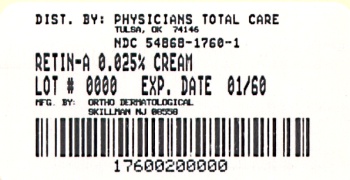
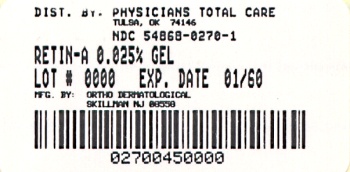
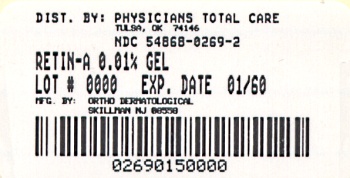
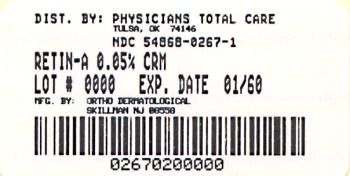
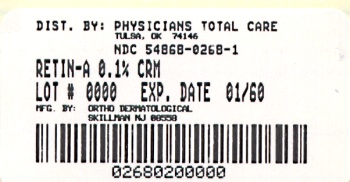

{{#ask: Label Page::Retinol |?Label Name |format=template |template=DrugLabelImages |mainlabel=- |sort=Label Page }}
Patient Counseling Information
There is limited information regarding Patient Counseling Information of Retinol in the drug label.
Precautions with Alcohol
- Alcohol-Retinol interaction has not been established. Talk to your doctor about the effects of taking alcohol with this medication.
Brand Names
There is limited information regarding Retinol Brand Names in the drug label.
Look-Alike Drug Names
There is limited information regarding Retinol Look-Alike Drug Names in the drug label.
Drug Shortage Status
Price
References
The contents of this FDA label are provided by the National Library of Medicine.

